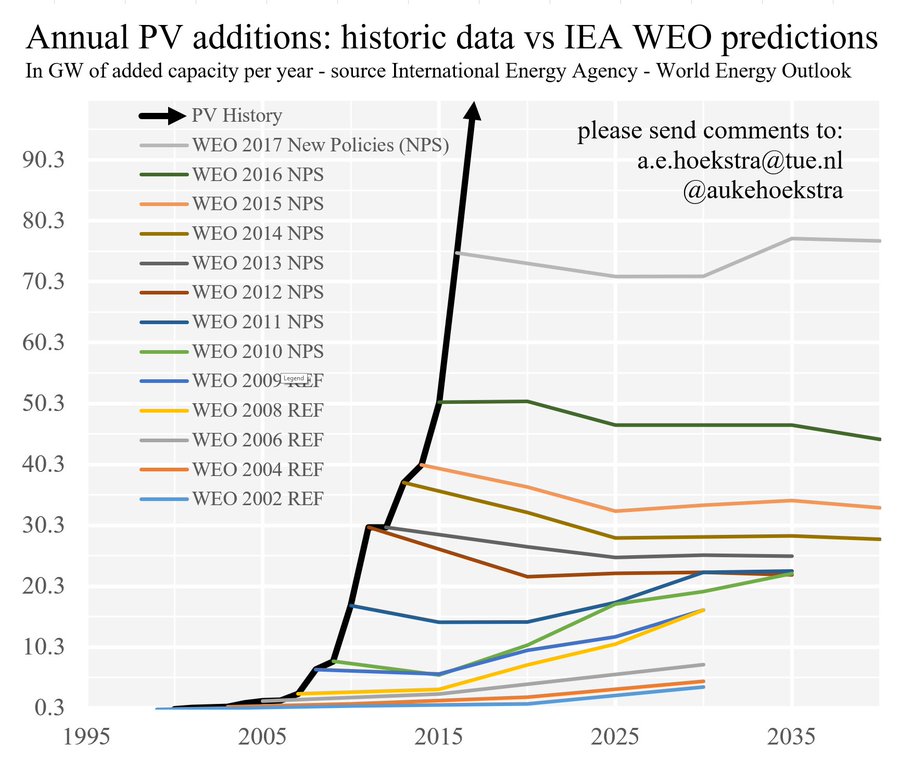The EIA has just published its 2020 Annual Energy Outlook.
You can always find the latest at:
Annual Energy Outlook
Discuss.
You can always find the latest at:
Annual Energy Outlook
Discuss.
You can install our site as a web app on your iOS device by utilizing the Add to Home Screen feature in Safari. Please see this thread for more details on this.
Note: This feature may not be available in some browsers.
The EIA has just published its 2020 Annual Energy Outlook.
You can always find the latest at:
Annual Energy Outlook
Discuss.
Good to see that solar is expected to beat wind. Makes sense since we use power mostly during the day time. If excess energy, we can store it in our EVs to use later in the evening.
| Plant type | 2022 Wgt | 2022 Unwgt | 2022 Min | 2022 Max | 2025 Wgt | 2025 Unwgt | 2025 Min | 2025 Max |
|---|---|---|---|---|---|---|---|---|
| Ultra-supercritical coal | . | . | . | . | . | 76.44 | 65.10 | 91.27 |
| Combined cycle | 33.53 | 36.27 | 31.25 | 45.06 | 36.61 | 38.07 | 33.35 | 45.31 |
| Combustion turbine | 64.19 | 62.81 | 55.23 | 73.61 | 68.71 | 66.62 | 58.48 | 81.37 |
| Advanced nuclear | . | . | . | . | . | 81.65 | 71.90 | 92.04 |
| Geothermal | . | . | . | . | 37.47 | 37.47 | 35.13 | 39.60 |
| Wind, onshore | 36.65 | 38.33 | 28.25 | 64.03 | 34.10 | 39.95 | 28.72 | 62.72 |
| Wind, offshore | . | . | . | . | 115.04 | 122.25 | 102.68 | 155.55 |
| Solar photovoltaic | 37.44 | 38.57 | 32.13 | 51.97 | 32.80 | 35.74 | 29.75 | 48.09 |
| Hydroelectric | . | . | . | . | 39.54 | 52.79 | 35.37 | 63.24 |

EIA does a decent job summarizing recent developments but its record for predicting the future of renewables would be pure comedy if it did not so tragically encourage overinvestment in fossil fuels by systematically underestimating the massive growth and rapidly falling costs for renewables.
Down below is an excellent chart that summarizes their past predictions for solar PV additions.
They have a truly horrible forecasting record whose main purpose and effect is to inflate investment in fossil fuels.
AukeHoekstra on Twitter

EIA (US Energy Information Administration) != IEA (International Energy Agency).
Maybe I need to change my sig.Done.

| Plant type | 2023 Wgt | 2023 Unwgt | 2023 Min | 2023 Max | 2026 Wgt | 2026 Unwgt | 2026 Min | 2026 Max |
|---|---|---|---|---|---|---|---|---|
| Ultra-supercritical coal | . | . | . | . | . | 72.78 | 64.98 | 88.45 |
| Combined cycle | 33.21 | 34.78 | 29.17 | 43.47 | 34.51 | 37.11 | 31.67 | 44.68 |
| Combustion turbine | 175.28 | 177.75 | 154.68 | 220.86 | 199.01 | 194.87 | 170.79 | 244.71 |
| Advanced nuclear | . | . | . | . | . | 69.39 | 64.82 | 78.15 |
| Geothermal | . | . | . | . | 36.02 | 36.40 | 33.41 | 39.55 |
| Biomass | . | . | . | . | 36.02 | 89.21 | . | 130.97 |
| Battery Storage | 121.85 | 117.59 | 106.63 | 127.64 | 36.02 | 119.84 | 121.84 | 131.42 |
| Wind, onshore | 30.44 | 33.53 | 25.09 | 56.12 | 31.45 | 36.93 | 26.33 | 56.94 |
| Wind, offshore | . | . | . | . | 115.04 | 120.52 | 97.52 | 149.53 |
| Solar, standalone | 30.63 | 33.13 | 27.65 | 44.46 | 31.30 | 32.78 | 27.28 | 43.90 |
| Solar, hybrid | . | 48.16 | 40.10 | 62.97 | 45.13 | 47.67 | 39.54 | 62.11 |
| Hydroelectric | . | . | . | . | . | 55.26 | 41.92 | 70.60 |
| Type | 2020 | 2021 |
|---|---|---|
| Ultra-supercritical coal | . | 85 |
| Combined cycle | 87 | 87 |
| Combustion turbine | 30 | 10 |
| Advanced nuclear | . | 90 |
| Geothermal | 90 | 90 |
| Biomass | . | 83 |
| Battery Storage | . | 10 |
| Wind, onshore | 40 | 41 |
| Wind, offshore | 45 | 44 |
| Solar, standalone | 30 | 29 |
| Solar, hybrid | . | 28 |
| Hydroelectric | 73 | 55 |
Yeah, it is pretty astounding.Down below is an excellent chart
Figure I post this chart here to compare in the future. Looks like projection is nominal increase of 2-2.2% annually.
View attachment 646775


